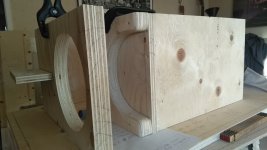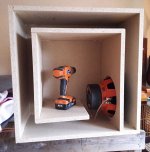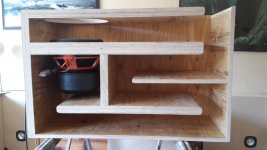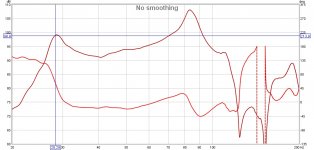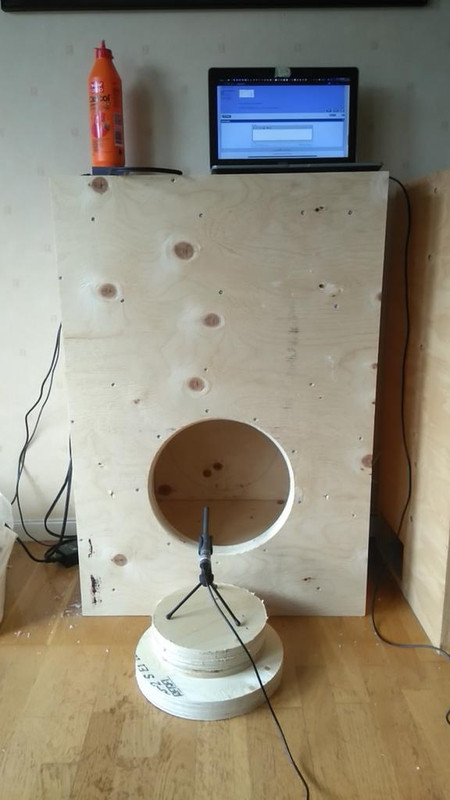Can you send your TH1 hornresp sim export files ? It's easy to export it in akabak files and correct it as you which.
Thanks for your offer to help me with this. My main workstation is down at the moment, and I don't have Hornresp or Windows on any working computer at the moment.
I will be back after this weekend. I hope to get Windows 7 and Hornresp up and running again soon.
Enclosure specs?
I will upload more after this weekend. Life is getting in the way of designing, simulating and building high order QW subwoofers.
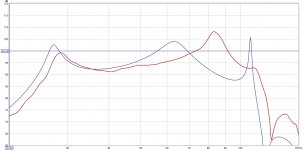
TH1 can not simulate this correctly, but it did give a good indication of the general pass band.
The large peaks and dips don´t scare me much in this design. It is meant to pressurize a car cabin, and the large wide 80 Hz midbass peak makes it sound punchy and fun, despite the huge voice coil inductance and the deep suckout above the passband.
This design might be a good candidate for a QB5 alignment. Basically it puts an active crossover in series, and the crossover reduces the peak. At the same time, power handling goes up like crazy, because the excursion at resonance is reduced dramatically.
Satellites and Subwoofers
This article focuses on vented QB5 alignments, but the concept can be applied to horns and tapped horns also.
Satellites and Subwoofers
This article focuses on vented QB5 alignments, but the concept can be applied to horns and tapped horns also.
This design might be a good candidate for a QB5 alignment. Basically it puts an active crossover in series, and the crossover reduces the peak.
I was planning on shaping the lower peak with the subsonic filter, which is quite similar to what the article describes. I will have to do some measurement sweeps and set the filter after I see the in cabin response.
Thanks for the link!
My experience with these driver in this kind of enclosure is that you run out of power long before excursion becomes a problem. With 3500 watts available we could push the driver to +- 20 mm excursion with music (Rebassed with lots of content below tuning).
The driver does +- 35 mm in free air before audible clipping from the voice coil traveling far enough to substantially lower Bl (it is a competition driver - it is not a low distortion driver).
YouTube
Excursion test of its 15 inch big brother.
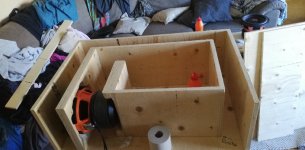
The last picture I got before my son closed up the box.
Enclosure specs?
It is 940 x 630 x 360 mm outer dimensions. Everything is 18 mm plywood or multiples thereof. Baffle and front piece (with 300 mm diameter port) is made of two layers for a total of 36 mm plywood.
The small piece with a large cutout for the magnet is three layers of plywood.
The Helmholtz front resonator chamber is 51 liters. The pipe section is 88 x 306 mm in cross section (except for last 40 cm section before it couples to the front resonator chamber, where it is 140 x 306 mm.
Between those 2 enclosures, which 1 performed better?
They are much too different to compare.
The large TPCH is with a GAS COMP12D1 with a Qts of 0,20. It is tuned to 31 Hz (28-29 Hz in a car cabin). It is designed for and used in car audio spl competition. It is currently used as a slightly overpowered home theater subwoofer with 750 watts of QSC power.
The square HROAR is with a much cheaper and simpler 10 inch GAS ALPHA10D2 driver. 0,30 in Qts. It is tuned to 43 Hz. It is used as a nice format bass "horn" in a 2.1 computer sound system for some Spotify, Netflix and gaming.
Both sound very good within their intended use.
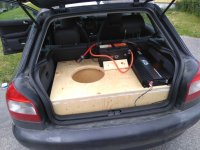
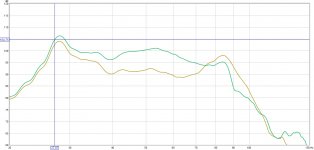
The large HROAR10 in place with a 3,5 kw amp and a extra battery.
The green response curve is on the dashboard near the front window.
The Yellow response curve is close to the drivers ear near the headrest.
The peak at 28 Hz is 4 dB lower due to some careful use of the subsonic filter. We did not want to lower the peak any more. The owner wants to have a very physical and tactile reproduction of bass. And it is very impressive already with a few hundred watts.
- Home
- Loudspeakers
- Subwoofers
- ROAR with Helmholtz front resonator
